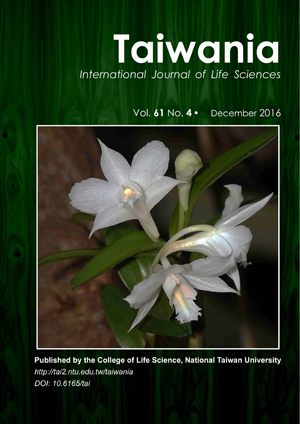Research Paper
Cytological studies in Four Endemic Genera of Apiaceae from India
Kumar Vinod C. Gosavi, Neeta A. Jadhav and Shrirang R. Yadav
Published on: 07 November 2016
Page: 314 - 318
DOI: 10.6165/tai.2016.61.314
Abstract
The family Apiaceae comprises 428 genera worldwide, of which 68 are represented in India. Karnataka P.K. Mukh. & Constance, Pinda P.K. Mukh. & Constance, Polyzygus Dalzell, Sivadasania N. Mohanan & Pimenov and Vanasushava P.K. Mukh. & Constance are endemic genera to the country. The present communication is an attempt to provide chromosome counts and basic karyomorphology of Karnataka, Pinda, Polyzygus and Vanasushava. Somatic chromosome counts 2n = 22 and meiotic chromosome counts n = 11 are reported for the first time in Karnataka and Pinda while in Polyzygus 2n = 36 and in Vanasushava 2n = 44 are reported as new cytotypes in present investigation. Karyomophologically Pinda and Vanasushava showed affinities with Heracleum L. while Polyzygus showed advanced karyotype symmetry.
Keyword: Apiaceae, Chromosome counts, Endemic genera, India, Karyomorphology
Literature Cited
Carbonnier, J. and D. Molho. 1977. Contribution phytochimique a letude de la position systamatique de Vanasushava pedata (Wight) Mukherjee et Constance (Heracleum pedatum Wight). Bull. Mus. Hist. Nat. 3: 1
Cauwet-Marc, A.M. 1977. Anatomie comparee du fruit de Vanasushava pedata (Wight) Mukherjee et Constance et de quelques genres voisins. Newsletter Umbell. 2: 30
Cerceau-Larrival, M. et al. 1977. Contribution palynologique a l'etude de Vanashushava pedata Ombellifere archaique du Sud de l'Inde. Pollen et Spore. 19: 285
Deng, X.L., X.J. He, W.L. He, Y.D. Gao, H.Y. Liu, Y.C. Zhang. 2009. Karyotype and cytogeography of the genus Heracleum (Apiaceae) in the Hengduan Mountains. J. Syst. Evol. 47(4): 273
DOI: 10.1111/j.1759-6831.2009.00031.xView Article
Google Scholar
Downie, S.R., K. Spalik, D.S. Katz-Downie, J. Reduron. 2010. Major clades within Apiaceae subfamily Apioideae as inferred by phylogenetic analysis of nrDNA ITS sequences. Plant Div. Evol. 128(1): 111
DOI: 10.1127/1869-6155/2010/0128-0005View Article
Google Scholar
Guyot, M. 1978. Contribution phytodermique (types stomatiques, morphologie des poils) a l
He, X.J. 1994. Studies on Karyotype of the Genus Heracleum from China. Acta Phytotaxonomica Sinica. 32: 32
Irwin, S.J. and D. Narasimhan. 2011. Endemic genera of Angiosperms in India: A Review. Rheedea 21: 87
Janardhanan, M. and J.E. Thoppil. 2003. Karyomorphological studies in Polyzygus tuberosus Dalz. ex Walp. by image analysis system.Nucleus 46: 59
Krishnappa, D.G. and A.N. Basappa.1988. SOCGI plant chromosome number reports - VI.J. Cytol. Genet. 23: 38
Kumar, S., S.M. Jeelani, S. Rani, S. Kumari, R.C. Gupta. 2014. Cytological evaluation of Apiaceae Lindl. from Western Himalayas. Cytology and Genetics. 48(4): 250
DOI: 10.3103/S0095452714040033View Article
Google Scholar
Levan, A., K. Fregda, A. A. Sandberg. 1964. Nomenclature for centromeric position on Chromosomes. Hereditas 52(2): 201
DOI: 10.1111/j.1601-5223.1964.tb01953.xView Article
Google Scholar
Logacheva, M.D., C.M. Valiejo-Roman, G.V. Degtjareva, J.M. Stratton, S.R. Downie, T.H. Samigullin, M.G. Pimenov. 2010. A comparison of nrDNA ITS and ETS loci for phylogenetic inference in the Umbelliferae: An example from tribe Tordylieae. Mol. Phylogenet. and Evol.57(1): 471
DOI: 10.1016/j.ympev.2010.06.001View Article
Google Scholar
Mabberley, D. J. 2008. The Plant Book. Cambridge University Press, Cambridge.
Mohanan, N. and G. Pimenov. 2007. Sivadasania, A New Genus of Apiaceae from Peninsular India. Botanicheskii Zhurnal. Moscow & Leningrad. 92: 900
Mukherjee, P.K. 1988. Vanasushava pedaita (Wight) P.K. Mukh. & Constance. In: Nayar M. P. and Sastry, A. R. K. (ed.), Red Data Book of Indian Plants. Vol. 2. Botanical Survey of India, pp. 30.
Mukherjee, P.K. and L. Constance. 1986a. A New Disposition of the South Indian Heracleum concanense Dalzell (Umbelliferae). Kew Bull. 41(1): 223
DOI: 10.2307/4103045View Article
Google Scholar
Mukherjee, P.K. and L. Constance. 1986b. Two New Genera of Indian Umbelliferae/Apiaceae Brittonia. 38(2): 145-149.
DOI: 10.2307/2807267View Article
Google Scholar
Mukherjee, P.K. and L. Constance. 1974. Vanasushava, an Old South Indian Umbellifer Renamed Author(s): Prasanta PK. Mukherjee and Lincoln Constance. Kew Bull. 29(3): 593
DOI: 10.2307/4108003View Article
Google Scholar
Mukherjee, P.K. and L. Constance. 1993. Umbelliferae (Apiaceae) of India. Oxford & IBH Publishing Co. Pvt. Ltd. New Delhi.
Nayar, M.P. 1996.Hot spots of endemic plants of India, Nepal and Bhutan. Tropical Botanic Garden and Research Institute, Thiruvananthapuram.
Paszko, B. 2006. A critical review and a new proposal of karyotype asymmetry indices. Pl. Syst. Evol. 258(1-2): 39
DOI: 10.1007/s00606-005-0389-2View Article
Google Scholar
Puneet, K. and V.K. Singhal. 2011. Chromosome number, male meiosis and pollen fertility in selected angiosperms of the cold deserts of Lahaul-Spiti and adjoining areas (Himachal Pradesh, India). Plant Syst. Evol.297(3-4): 271
DOI: 10.1007/s00606-011-0516-1View Article
Google Scholar
Romero, Z. C. 1986. New method for estimating karyotype asymmetry. Taxon 35(3): 526
DOI: 10.2307/1221906View Article
Google Scholar
Subramanian, D. 1986. Cytotaxonomical Studies in South Indian Apiaceae. Cytologia 51(1): 479
DOI: 10.1508/cytologia.53.67View Article
Google Scholar
Stebbins, G. 1971. Chromosomal Evolution in Higher Plants. Edward Arnold, London.
Wanscher, J.H. 2010. Studies on the Chromosome Numbers of the Umbellifere. Hereditas15(2): 179
DOI: 10.1111/j.1601-5223.1931.tb02548.xView Article
Google Scholar
Yu, Y., S. R. Downie, X. He, X. Deng and L. Yan. 2011. Phylogeny and biogeography of Chinese Heracleum (Apiaceae tribe Tordylieae) with comments on their fruit morphology. Pl. Syst. Evol. 296 (3
DOI: 10.1007/s00606-011-0486-3View Article
Google Scholar


